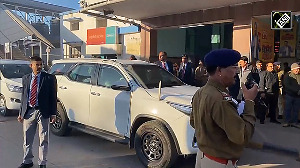 Researchers are developing a new generation of humanoid robots to live among people, perform surgery and even beat humans at football.
Researchers are developing a new generation of humanoid robots to live among people, perform surgery and even beat humans at football.
Developed in Bristol and Essex, the robots are being designed to do rescue work, clear sewers and become human companions.
Scientists even hope some of the humanoid designs will one day compete -- and beat -- humans in football matches, the Daily Mail reported.
Some robots can walk, talk and dance, speak 20 languages, hold conversations and respond with life-like expressions.
The BERT2 humanoid can interact with humans using an expressive face and artificial hands.
Theoretically, it could be controlled from anywhere in the world and so could be the forerunner of a robotic surgeon performing remote operations around the globe.
Others have been inspired by nature and can swim like fish or mimic the flight of birds and insects.
The Robotic Fish, which has the 'natural speed and motion of a large carp', can operate autonomously and is designed to monitor water pollution and detect leaks from ships in harbour.
Dr Ioannis Ieropoulos, senior researcher at the Bristol Robotic Laboratory, said the scientists had looked to nature for inspiration.
"Natural systems demonstrate perfectly that most
"By drawing inspiration from these living proofs we can achieve difficult tasks that would otherwise have been impossible," Ieropoulos said.
One of his personal creations is the EcoBot III, which can power itself by 'feeding' on sewage water.
The water provides nutrients for the robot's fuel cells and these generate electricity to power it.
Others like the Shrewbot and SCRATCHbot, which both have sensitive 'whiskers', could be used in rescue missions to search pitch-black caves.
The iCub -- a 'robot youngster' modelled on a three-and-a-half year old child -- is designed to give insight into how real humans develop and learn from their environment.
The Robothespian, made by Engineered Arts Ltd of Cornwall, is a 'humanoid acting robot' which can be programmed to move like a human actor. It uses facial-recognition software to mimic human movement and respond to faces.
Nao is a robot that can walk, talk, dance and respond to human speech.
They have spent time in paediatric wards, where it gives advice and support to young patients with chronic illnesses like diabetes.
Jules and Eve are humanoid heads, which are able to talk and respond to people with human-like facial expressions.
They are covered in a synthetic skin for a lifelike appearance.











 © 2025 Rediff.com -
© 2025 Rediff.com -